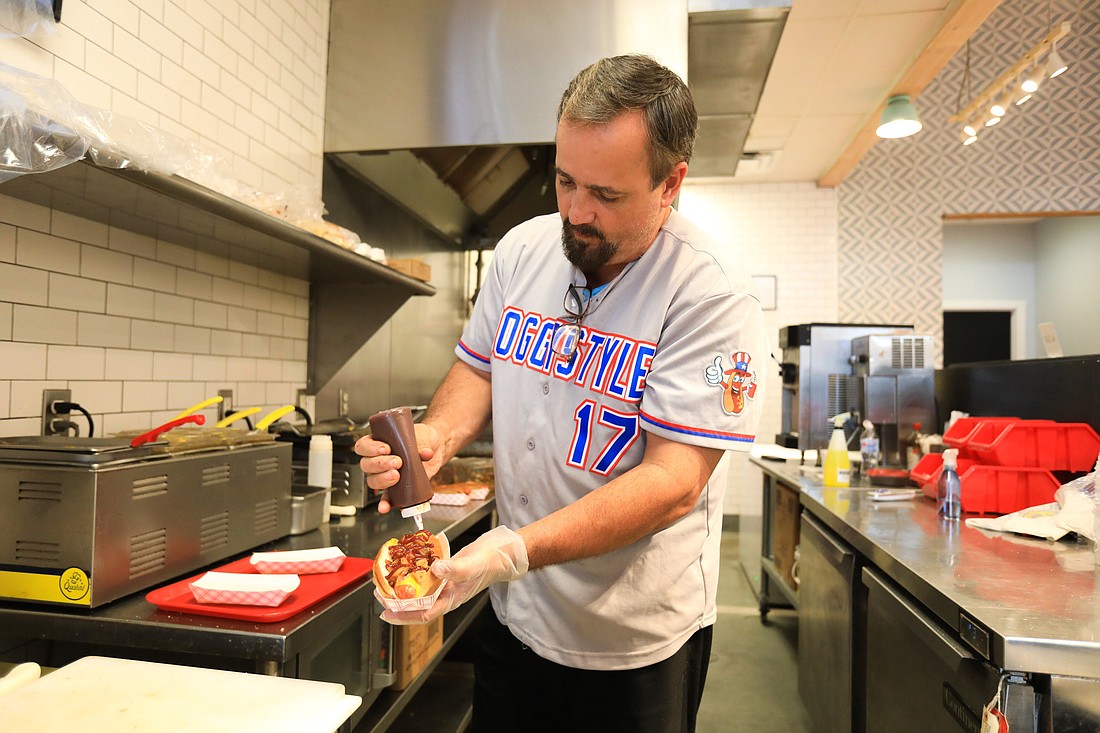- June 1, 2025
-
-
Loading

Loading

What makes a good hot dog?
The answer often depends on who you are and where you're from.
Andrew Mincieli was born and raised in New York and has had his answer for years.
“I love a good hot dog with tomatoes and onions,” Mincieli said. “A Sabrett hot dog with a natural casing so that when you bite into it, it almost snaps at you.”
The problem is he couldn’t find the exact flavor and feeling upon moving to the Sarasota area years ago. Mincieli started buying ingredients at home and making the hot dogs himself, but it wasn’t the same.
He found a better solution upon visiting the Doggystyle restaurant in downtown Sarasota, founded by Connecticut native-turned-Sarasota resident Steve DiBio.
The hot dog locale has one specific hook: Its menu highlights hot dog styles from specific regions. That includes styles Chicago, Philadelphia, Texas, Kansas City and, importantly for Mincieli, a New York-style dog that was exactly what he was looking for.
“(The New York hot dog) was exactly what I was used to,” Mincieli said. “If I’m ever anywhere near (DiBio’s) place, I get a hot dog there. You just can’t get a good hot dog here.”
DiBio has been keeping track of the hot dog recipes and variations for years.
Following his time as a minor league baseball player, DiBio jotted down each recipe and variation in approach. He’s been collecting those notes for three decades but only comparatively recently decided to put that knowledge into effect when he opened his restaurant.
Red onion sauce? That’s a New York thing. Anyone from West Virginia down to Georgia goes for mustard, chili and coleslaw, though DiBio notes West Virginians often add onions while Georgians removes the chili to make it a slaw dog. Memphis dog shops put bacon, barbecue sauce and onions on theirs. And one area of the country that DiBio won’t name likes to eat their hot dogs with barbecued macaroni and cheese.
“We wanted to give (tourists) here a little taste of home,” DiBio said. “People say it’s difficult to find good pizza. It’s also just hard to find a good hot dog.”
DiBio’s family grew up in the culinary world — he started working in restaurants when he was 14 growing up in Connecticut — but his path to accumulating hot dog recipes came from a different place.
He started traveling in the minor leagues where he played pitcher in 1989.
That took him around the country, and DiBio felt like seeing what the different regions he visited had to offer when it came to food.
“I had a hankering for a hot dog (while in the Carolinas), but it was just disappointing,” DiBio said. “I started questioning where I could get a good hot dog. … A lot of places just had plain old boiled hot dogs.”
As DiBio went from town to town, he noticed a contrast in how people went about their dogs and an even more granular schism in whether the meat or toppings were championed.
Some areas like the Carolinas, for example, could have any kind of average hot dog meat but rely heavily on toppings. Other places prized the type of hot dog being served and were fine mixing up the toppings.
“Where I was from, the hot dog was king but people would top theirs differently,” DiBio said. “There, no one would know what dog they were eating but the toppings were eccentric. … I ask people if they grew up with the hot dog or they grew up with the topping.”
Dakota DuBois, originally from Massachusetts, has missed the New England style of hot dog since moving to Sarasota two years ago. He’s been able to get a taste of home since randomly walking into Doggystyle.
“The outside of a New England style bun is like bread that can be toasted, it’s not a bulky, round exterior that you find in Publix,” DuBois said. “The meat that goes into it just tastes better than what goes into a typical Oscar Meyer. I’ve been missing it — it’s what I’m used to.”
DiBio chalks up much of the variation and influence of various recipes and styles across the country to cultural impact from immigration that’s been spread out through the decades.”
“If you grew up in an industrial area with jobs and immigration, you had 1,000 years of European food culture dropped on your doorstep,” DiBio said. “New York, Chicago, Philadelphia, Newark, immigrants came with a built-in customer base and supply chains were built to feed all these people.”
He doesn’t see Florida having much of an innate hot dog culture — he says the biggest immigration-based contribution to Florida’s food culture is the Cuban sandwich — but he has noticed barbecue sauce toppings becoming more and more popular.
The demographics that visit Doggystyle have been changing as the greater Sarasota area changes as well.
Many visitors have come from the Midwest — Chicago and Michigan especially — but DiBio has noticed a greater influx of northerners that have asked for their own unique recipes as the months have gone on. And that’s to say nothing of the vegans.
“The hot dog, in some ways, was dying (culturally), but we’re tacking in a different direction,” DiBio said. “People think it’s interesting.